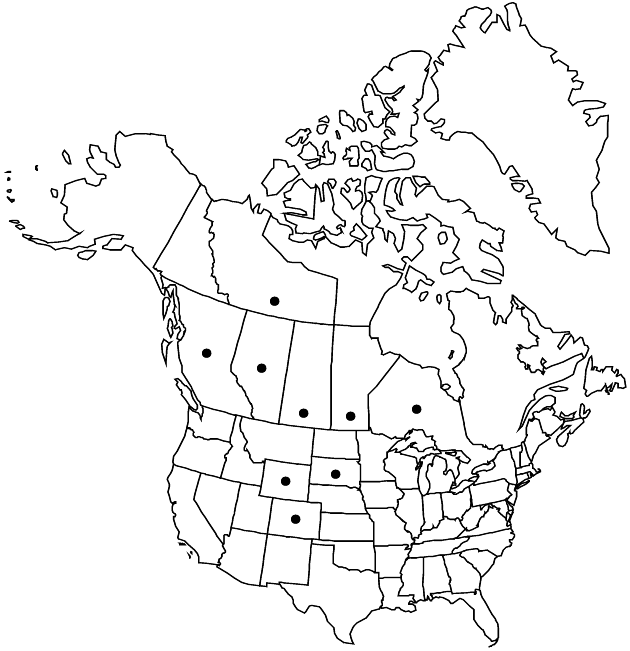Difference between revisions of "Cirsium drummondii"
Fl. N. Amer. 2: 459. 1843.
FNA>Volume Importer |
imported>Volume Importer |
||
| (6 intermediate revisions by 2 users not shown) | |||
| Line 8: | Line 8: | ||
}} | }} | ||
|common_names=Drummond’s or dwarf or short-stemmed thistle | |common_names=Drummond’s or dwarf or short-stemmed thistle | ||
| + | |special_status={{Treatment/ID/Special_status | ||
| + | |code=E | ||
| + | |label=Endemic | ||
| + | }} | ||
|basionyms= | |basionyms= | ||
|synonyms={{Treatment/ID/Synonym | |synonyms={{Treatment/ID/Synonym | ||
|name=Cirsium coccinatum | |name=Cirsium coccinatum | ||
|authority=Osterhout | |authority=Osterhout | ||
| + | |rank=species | ||
}} | }} | ||
|hierarchy=Asteraceae;Asteraceae tribe Cardueae;Cirsium;Cirsium drummondii | |hierarchy=Asteraceae;Asteraceae tribe Cardueae;Cirsium;Cirsium drummondii | ||
| Line 27: | Line 32: | ||
|elevation=300–2300 m | |elevation=300–2300 m | ||
|distribution=Alta.;B.C.;Man.;N.W.T.;Ont.;Sask.;Colo.;S.Dak.;Wyo. | |distribution=Alta.;B.C.;Man.;N.W.T.;Ont.;Sask.;Colo.;S.Dak.;Wyo. | ||
| − | |discussion=<p>Cirsium drummondii is widely distributed across Canada from the Northwest Territories to British Columbia and Ontario. The name C. drummondii has been misapplied to a wide range of plants across the western United States that are now treated as one or another variety of the polymorphic C. scariosum. The only documented modern occurrences of C. drummondii in the United States are in the Black Hills of South Dakota and adjacent Wyoming. Specimens collected by Hall and Harbour (342) are the only ones of C. drummondii known from Colorado. Somewhat similar plants from northern Nevada are treated here as C. scariosum var. toiyabense. During Pleistocene glaciations the ancestors of C. drummondii undoubtedly occupied a more southerly distribution and very likely came into direct contact with populations of C. scariosum. The observed similarities between C. drummondii and C. scariosum var. toiyabense are probably a relict of that ancient contact.</p> | + | |discussion=<p><i>Cirsium drummondii</i> is widely distributed across Canada from the Northwest Territories to British Columbia and Ontario. The name <i>C. drummondii</i> has been misapplied to a wide range of plants across the western United States that are now treated as one or another variety of the polymorphic <i>C. scariosum</i>. The only documented modern occurrences of <i>C. drummondii</i> in the United States are in the Black Hills of South Dakota and adjacent Wyoming. Specimens collected by Hall and Harbour (342) are the only ones of <i>C. drummondii</i> known from Colorado. Somewhat similar plants from northern <i>Nevada</i> are treated here as <i>C. scariosum </i>var.<i> toiyabense</i>. During Pleistocene glaciations the ancestors of <i>C. drummondii</i> undoubtedly occupied a more southerly distribution and very likely came into direct contact with populations of <i>C. scariosum</i>. The observed similarities between <i>C. drummondii</i> and <i>C. scariosum </i>var.<i> toiyabense</i> are probably a relict of that ancient contact.</p> |
|tables= | |tables= | ||
|references= | |references= | ||
| Line 36: | Line 41: | ||
-->{{#Taxon: | -->{{#Taxon: | ||
name=Cirsium drummondii | name=Cirsium drummondii | ||
| − | |||
|authority=Torrey & A. Gray | |authority=Torrey & A. Gray | ||
|rank=species | |rank=species | ||
| Line 50: | Line 54: | ||
|publication title=Fl. N. Amer. | |publication title=Fl. N. Amer. | ||
|publication year=1843 | |publication year=1843 | ||
| − | |special status= | + | |special status=Endemic |
| − | |source xml=https:// | + | |source xml=https://bitbucket.org/aafc-mbb/fna-data-curation/src/2e0870ddd59836b60bcf96646a41e87ea5a5943a/coarse_grained_fna_xml/V19-20-21/V19_149.xml |
|tribe=Asteraceae tribe Cardueae | |tribe=Asteraceae tribe Cardueae | ||
|genus=Cirsium | |genus=Cirsium | ||
Latest revision as of 20:48, 5 November 2020
Biennials or monocarpic perennials, acaulescent or caulescent, 5–110 cm; taproots stout. Stems erect, stout, fleshy, leafy, simple or distally branched, villous or tomentose with long, septate trichomes; branches usually short, stout, ascending. Leaves: blades oblong-elliptic to oblanceolate, 15–30+ × 3–7 cm, usually shallowly to deeply pinnatifid, lobes ovate to broadly triangular, spreading, usually separated by broad U-shaped sinuses, spinose-dentate or coarsely lobed, main spines 2–5(–8) mm, slender, abaxial faces villous with septate trichomes, at least along veins, sometimes thinly arachnoid, adaxial villous with septate trichomes; basal often present at flowering, spiny winged-petiolate; principal cauline winged-petiolate or sessile, not much reduced distally; distal reduced, similar to proximal, crowded around heads. Heads 1–5(–9), borne singly or crowded in corymbiform arrays at tips of main stems, often closely subtended and overtopped by 1–several distal leaves. Peduncles 0–5(–10) cm, leafy-bracted. Involucres broadly ovoid to hemispheric, 3.5–5 × 3.5–5 cm (appearing much wider and ± campanulate in pressed specimens), loosely arachnoid on phyllary margins or glabrate. Phyllaries in 4–6 series, strongly imbricate, ovate or broadly lanceolate (outer) to lance-linear (inner), abaxial faces with ± narrow glutinous ridge; outer and mid appressed, spines erect to ascending, 2–3 mm; apices of mid and inner narrowed and scabrid-denticulate, innermost spineless, with expanded, flexuous, erose-denticulate tips. Corollas purple (white), 30–48 mm, tubes 17–30 mm, throats 6.5–11 mm, lobes 5–7 mm; style tips 5–7 mm. Cypselae stramineous to light brown, 3.5–5.5 mm, apical collar yellow, narrow; pappi 30–42 mm.
Phenology: Flowering summer (Jun–Aug).
Habitat: Dry to moist soil, prairies, pastures, meadows, forest edges, woodland openings, roadsides
Elevation: 300–2300 m
Distribution

Alta., B.C., Man., N.W.T., Ont., Sask., Colo., S.Dak., Wyo.
Discussion
Cirsium drummondii is widely distributed across Canada from the Northwest Territories to British Columbia and Ontario. The name C. drummondii has been misapplied to a wide range of plants across the western United States that are now treated as one or another variety of the polymorphic C. scariosum. The only documented modern occurrences of C. drummondii in the United States are in the Black Hills of South Dakota and adjacent Wyoming. Specimens collected by Hall and Harbour (342) are the only ones of C. drummondii known from Colorado. Somewhat similar plants from northern Nevada are treated here as C. scariosum var. toiyabense. During Pleistocene glaciations the ancestors of C. drummondii undoubtedly occupied a more southerly distribution and very likely came into direct contact with populations of C. scariosum. The observed similarities between C. drummondii and C. scariosum var. toiyabense are probably a relict of that ancient contact.
Selected References
None.